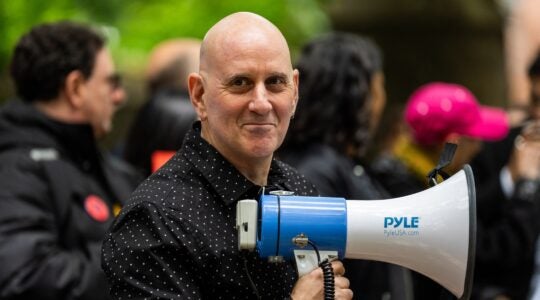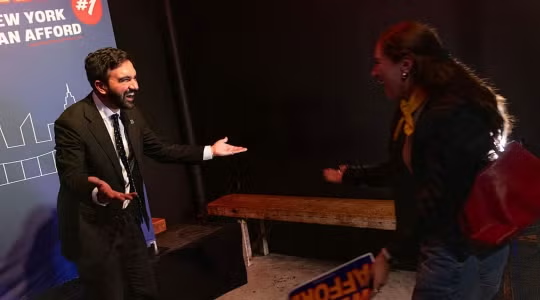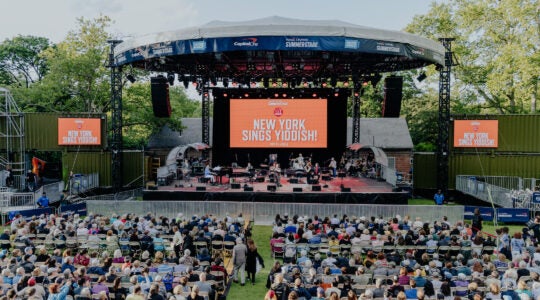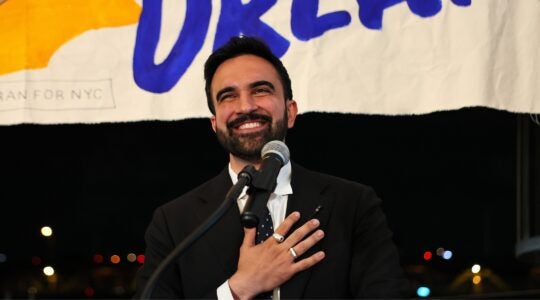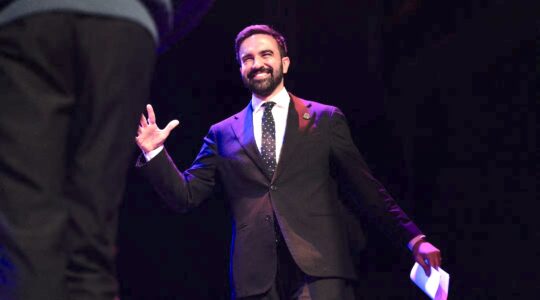It’s no coincidence that the new Haggadah written by Rabbi Kerry Olitzky opens with the image of a pineapple. After all, the subtitle of “Welcome to the Seder” is “A Passover Haggadah for Everyone,” and the pineapple is a Colonial-era symbol of welcome.
Rabbi Olitzky wrote this version of the ritual Passover volume, illustrated by Rinat Gilboa and published this year by New Jersey’s Behrman House, with the intention of making everyone who happens to be sitting at the seder table feel comfortable and included.
“This is for the family who invites lots of guests who come from different backgrounds, and wants to be as welcoming as they can be,” the rabbi said.
Recognizing the needs of different Jewish subcultures served as the inspiration for so many of the early creative Haggadot; there were Haggadot for vegetarians, some centering on Soviet Jewry, others with a feminist message, and still others paying tribute to Holocaust survivors, among the hundreds of specialized texts. But the irony was that such Haggadot seemed exclusively for and about particular groups or concepts. More mainstream Haggadot, whether for children or scholars, for learned families or those with little background, mostly did not bring in marginalized groups.
Enter Rabbi Olitzky, who has spent the last 20 years reaching out to people on the margins and bringing them into the mainstream. From 2000 until it closed its doors last year, he served as executive director of the Jewish Outreach Institute (renamed Big Tent Judaism in 2007), which was founded in 1988 by sociologist Egon Mayer. A prolific author, Rabbi Olitzky, who lives in North Brunswick, N.J., has written two other Passover books, one a Haggadah with Rabbi Ron Isaacs, the other a volume on preparing for the holiday.
Rabbi Olitzky told NJJN he views “Welcome to the Seder” as the culmination of the work he’s been doing on inclusivity. “In the white spaces of the texts,” he said, “are the last 20 years working to make Judaism as engaging as possible for those on the periphery, for those who have been historically disenfranchised, for those who have been excluded” from the Jewish experience.
The narrative of the new work is streamlined, with considerably reduced sections, like Birkat Hamazon (Grace After Meals) and Hallel (prayers of thanksgiving); but there are signposts along the way for people used to a more traditional Haggadah. The rabbis in B’nei Brak make an appearance, as do some instances of awkward but familiar language, like “The Egyptians set harsh taskmasters over the Israelites.”
There are tidbits thoughtfully planted throughout the Haggadah that draw varied traditions into the narrative. Roasted peanut charoset from the Ugandan-Jewish community gets a mention, as does a colorful custom of the Jews in India, who dip their hands in red paint at the beginning of the seder and then press their hands on paper to create a hamsa, or amulet to ward off evil, which they hang near the seder table.
“In the white spaces of the texts, are the last 20 years working to make Judaism as engaging as possible for those on the periphery.”
The “Serenity” prayer accompanies the section on bitterness, along with a quote from Rabbi Mark Borovitz of Beit T’Shuva, which for a long time was the only Jewish residential addiction treatment center. Those elements offer “a way of subtly affirming the presence of people in recovery from alcoholism at the seder, without being in-your-face about it,” said Rabbi Olitzky.
And non-Jewish customs that echo rituals at the seder also find a place in the Haggadah’s margins, including washing-of-the-hands ceremonies from Native American tradition and Islamic culture; as well as Buddhist, Christian, Shaker and Muslim prayers before eating.
“It recognizes that the people sitting around the table may have experiences within their own traditions with water” or food, said Rabbi Olitzky. “It’s a way to bring them closer to the Jewish experience.”
“The freedom story has become a story for many people.”
The Haggadah also reflects another reality about the Exodus from Egypt: “The freedom story has become a story for many people,” said the rabbi. “The civil rights movement adopted the story, the liberation movement in South Africa adopted the story, abolitionists adopted the story. Many people through history have adopted the story and made it their own, and that is reflected in this Haggadah.”
Acknowledging this widespread adoption, he introduced quotes from public intellectuals and politicians, from diverse writers, even from a nun.
The design is sparse and airy, with plenty of empty space on the pages, and Rabbi Olitzky took pains to omit many of the sidebars he had initially assembled. “I wanted to be careful because as the rabbis say, sometimes too much becomes too little.”
Gilboa’s illustrations are lyrical and evocative, blending a watercolor palette with layered textures. She combines traditional acrylic and watercolor brush strokes; different papers, fabrics and textures; and digital illustration to create expressive collages. The images echo the essential idea of inclusivity, with faces and bodies in hues from tan and brown to yellowish and blue. Gilboa told NJJN that “in Rabbi Olitzky’s text, I saw the ancient Haggadah text in a new light — a more global, open and holistic approach to the Haggadah story.”
Other new Haggadahs of note:
The Dry Bones Passover Haggadah by Yaakov Kirschen (Koren Publishers, $16.95)
A familiar presence for two generations in the English-speaking Jewish world since he made aliyah and began writing his Dry Bones cartoon for the Jerusalem Post and newspapers in this country, including this one, Kirschen came out with his own illustrated Haggadah. Full of wry commentaries, funded by Kickstarter and published by Kirschen himself several years ago, it was available in softcover and PDF versions. Now Koren, a major Israeli publisher, has come out with a hardcover edition.
Following the success of Kirschen’s original version, which sold nearly 10,000 copies and PDF printouts in more than a dozen countries, he was approached by Koren, whose edition includes the same text and drawings, an author’s introduction and appearances by his ubiquitous Uncle Shuldig character.
“The Dry Bones Passover Haggadah” is “a family message to the kids, the grandparents, fathers, mothers, friends, etc.,” said Kirschen, a graduate of Queens College who turns 80 this year and marks more than four decades at the Jerusalem Post.
“I created the Haggadah with the dream of making it the Haggadah for generations of Jews to come.”
♦
Signs and Wonders: 100 Haggada Masterpieces by Adam S. Cohen (The Toby Press, $39.95)
Though not strictly speaking a Haggadah or a Haggadah supplement, Cohen’s book can serve as an adjunct to the former and as a visual aid to the latter.
Cohen, associate professor in the history department of the University of Toronto, and former assistant director of the school’s Centre for Jewish Studies, has brought together 166 images as well as erudite explanations from seven-plus centuries of Haggadot from around the world.
The full-color book offers fascinating history and striking visuals, but anyone fearful of food or wine stains might but be reluctant to use the Haggadah at the seder table.
Cohen’s “tasting menu” of Haggadot can be great fodder for seder-table discussion. “I don’t imagine everyone will — or should — agree with all my choices,” he said. “I was trying to find Haggadot that are representative of the entire 700-year history of the phenomenon, and … find items that are exceptional works of art.”
The Haggadot that made the cut range from the “Birds Head Haggadah”(early 14th century) to “The Rose Haggadah” (2014) and the Maxwell House Haggadah, an English-language favorite since 1932.
“I will confess that it” — the ubiquitous Maxwell House version — “is more important historically than art-historically, and probably shouldn’t be considered a ‘masterpiece,’” said Cohen, whose expertise is medieval art. But I just couldn’t exclude what is arguably the most familiar Haggadah in history.”
Attending childhood seders in Brooklyn and Merrick, L.I., Cohen read from the Maxwell House Haggadah and a variety of other ones. In recent years, as leader of his own seders, he has distributed “selected Haggadah images” to pique the interest of participants.
Over the years, he estimated, he has looked at some 2,000 Haggadot, from which he made the selections for his book.
Does he have personal favorites? “Certainly,” he said, “ but for political reasons I will keep those a secret.”
♦
Rosenberg English Holocaust Haggadah for Passover: Holocaust Poems and Essays to Supplement the Seder by Rabbi Bernhard Rosenberg. (Self-published, no price given; available at holocausthaggadah.com).
The title of Rabbi Rosenberg’s Haggadah tells the whole story — it is personal; it has a Shoah theme; it is all in English, with no Hebrew or Aramaic, as in a traditional Haggadah; and it contains dozens of literary works fit to be read throughout the holiday evening.
The rabbi, born in a Displaced Persons camp to Polish-born Holocaust survivors, put together this supplement after teaching for years in a New Jersey day school and authoring several books about the Holocaust. It’s intended to be a tribute to the victims and survivors — a reminder to post-Holocaust generations to keep the memory of that experience alive, and an education in what happened.
“If you want to fight against anti-Semitism, if you want to keep the memory of the Holocaust alive, you have to keep retelling the story.”
“We must incorporate in our religious services and religious traditions, memoirs, readings, and liturgy, readings concerning the Holocaust,” Rabbi Rosenberg, now emeritus spiritual leader of Congregation Beth-El in Edison, N.J., writes in the Haggadah’s introduction. “Reading about the Holocaust must become part of every Jewish holiday.”
The rabbi, who serves on New Jersey’s Holocaust Commission and chairs the New York Board of Rabbis’ Holocaust Commission, includes in his book essays, poetry and short stories written by students at the day school where he taught, as well as contributions by survivors and their descendants. A few of the rabbi’s own writings, some discussion questions and black-and-white historical photos are also part of the book.
The message of the Haggadah is simple, Rabbi Rosenberg said: “If you want to fight against anti-Semitism, if you want to keep the memory of the Holocaust alive, you have to keep retelling the story.”
The New York Jewish Week brings you the stories behind the headlines, keeping you connected to Jewish life in New York. Help sustain the reporting you trust by donating today.
